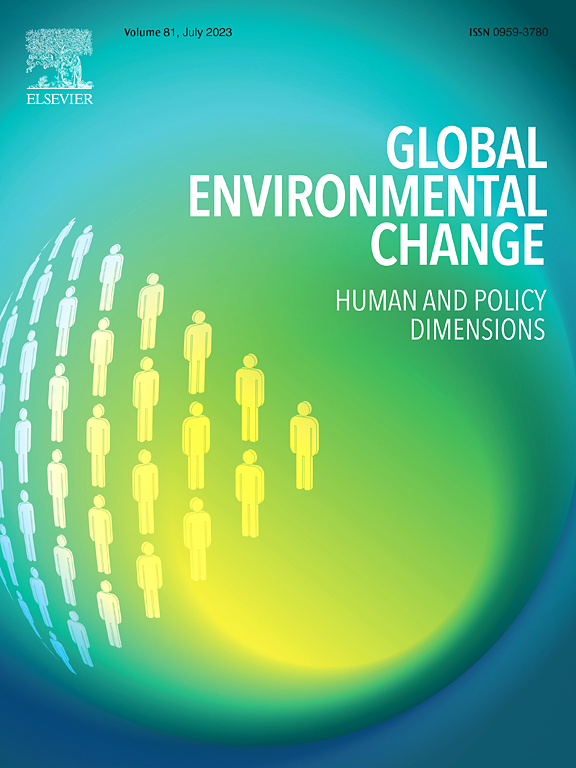权力的多面谱——不同旱地地区权力结构的参与式网络分析
IF 9.1
1区 环境科学与生态学
Q1 ENVIRONMENTAL SCIENCES
引用次数: 0
摘要
随着气候变化对干旱地区的影响日益加剧,必须更好地了解行为体如何相互关联,以可持续地管理自然资源。关于环境治理网络的文献研究了行动者的合作,但它才刚刚开始调查维持冲突情况的网络。此外,虽然传统上被定义为有权力的行为者受到了重要的学术关注,但那些没有正式权力或关键财政资源的人,以及他们的权力来源,却没有得到重视。在本文中,我们分析了Net-Map数据,以更好地理解传统上不被认为具有影响力的演员群体的权力来源,因此他们在演员网络中被忽视。我们使用社会网络分析和权力类型学来理解这些行为者在网络中的联系,旨在解释为什么传统上被忽视的行为者被认为特别有影响力。我们将这些方法应用于三个案例国家的当地站点,都位于干旱地区。举办了由不同群体参加的Net-Map讲习班,重点是农业生产系统。结果表明,在决策领域中传统上一直被忽视、现在仍然被忽视的各种各样的行为者,被认为在其所在地区具有特别的影响力,这指出了理解和行使权力的各种模式。对自然资源的争夺,揭示了冲突的紧张局势在权力关系中所起的作用。通过这项工作,对行动者网络中的权力不对称有了更广泛的理解。本文章由计算机程序翻译,如有差异,请以英文原文为准。
The multifaceted spectra of power − A participatory network analysis on power structures in diverse dryland regions
With intensifying climate change impacts on dryland regions, it is essential to better understand how actors relate to each other to sustainably manage natural resources. The literature on environmental governance networks has studied actor collaborations, but it is only starting to investigate networks that sustain conflictive situations. Moreover, while actors traditionally defined as powerful have received important scholarly attention, those who do not hold formal authority or key financial resources have not, as well as their sources of power. In this paper we analyse Net-Map data to better understand the sources of power of actor groups that traditionally are not perceived as influential, hence they are neglected in actor networks. We use social network analysis and a typology of power to understand these actors’ links in the networks, aiming to decipher what might explain why the traditionally neglected actors are perceived as particularly influential. We apply these methods to local sites in three case countries, all located in dryland regions. Net-Map workshops with diverse groups of participants were held with a focus on agricultural production systems. The results reveal that a broad variety of actors that traditionally have been, and still are, neglected in decision making domains, are perceived as particularly influential in their regions, pointing to the various modes in which power is understood and exercised. The competing interests over natural resources shed light on the role that conflictive tensions played in power relations. Through this work a broader understanding of power asymmetries in actor networks is gained.
求助全文
通过发布文献求助,成功后即可免费获取论文全文。
去求助
来源期刊

Global Environmental Change
环境科学-环境科学
CiteScore
18.20
自引率
2.20%
发文量
146
审稿时长
12 months
期刊介绍:
Global Environmental Change is a prestigious international journal that publishes articles of high quality, both theoretically and empirically rigorous. The journal aims to contribute to the understanding of global environmental change from the perspectives of human and policy dimensions. Specifically, it considers global environmental change as the result of processes occurring at the local level, but with wide-ranging impacts on various spatial, temporal, and socio-political scales.
In terms of content, the journal seeks articles with a strong social science component. This includes research that examines the societal drivers and consequences of environmental change, as well as social and policy processes that aim to address these challenges. While the journal covers a broad range of topics, including biodiversity and ecosystem services, climate, coasts, food systems, land use and land cover, oceans, urban areas, and water resources, it also welcomes contributions that investigate the drivers, consequences, and management of other areas affected by environmental change.
Overall, Global Environmental Change encourages research that deepens our understanding of the complex interactions between human activities and the environment, with the goal of informing policy and decision-making.
 求助内容:
求助内容: 应助结果提醒方式:
应助结果提醒方式:


